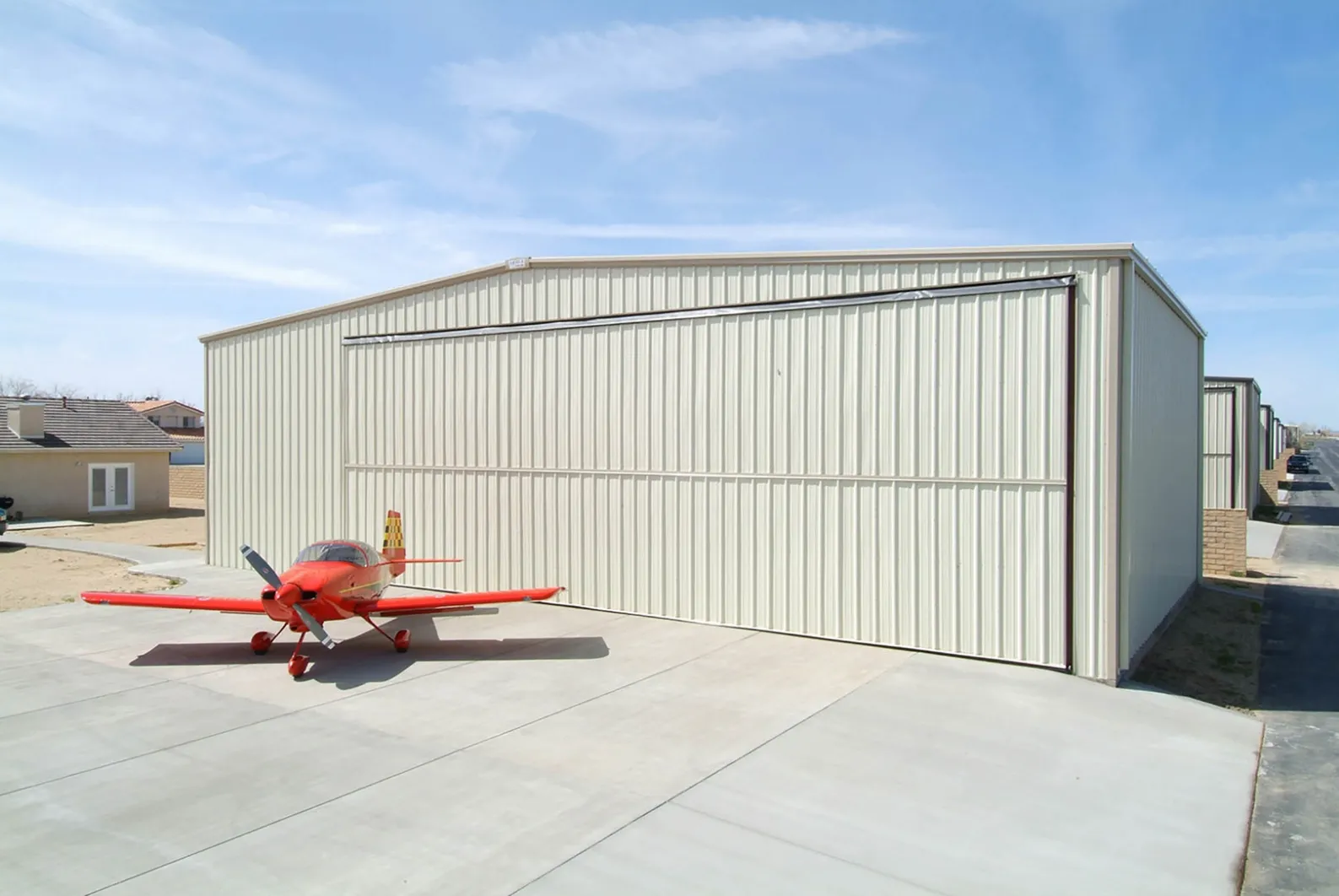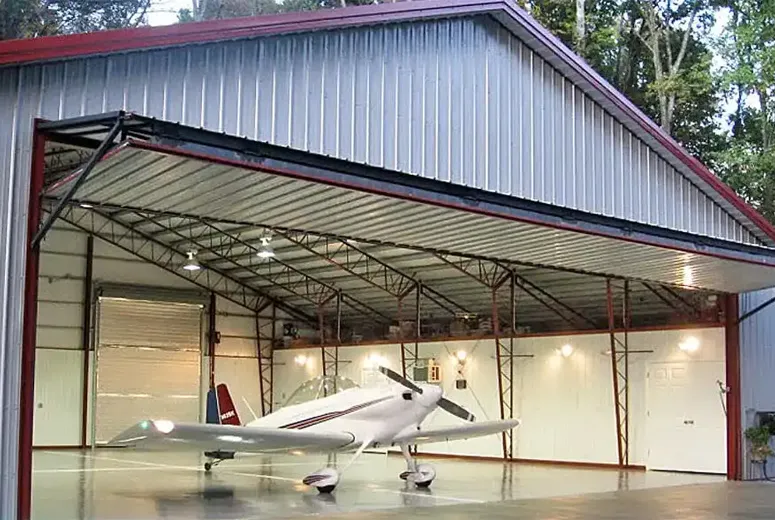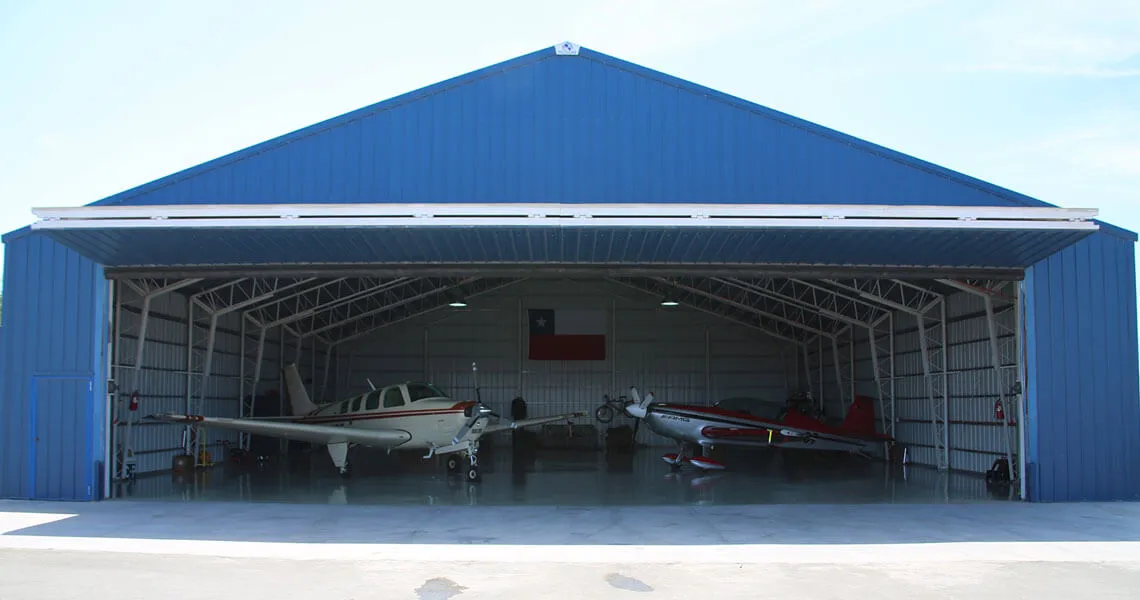Air hanger buildings are specialized structures designed to store and maintain aircraft. These buildings are essential for both commercial aviation and private aircraft operations, providing a safe, secure, and efficient space for aircraft storage, maintenance, and repair.
1. Large Span and Clear Interior Space
Air hanger buildings are built with a large, open interior space to accommodate various types of aircraft, ranging from small private planes to large commercial jets. The design typically includes clear-span construction, meaning there are no internal columns or supports to obstruct movement within the hanger, allowing for easy maneuvering and access to aircraft.
2. Durable and Strong Construction
The structure of air hanger buildings is typically made from steel, which provides high strength and durability. Steel is resistant to environmental factors such as wind, rain, and corrosion, ensuring the hanger remains secure and functional over time. Additionally, steel construction is fire-resistant, providing added protection for valuable aircraft.
3. Large Doors and Accessibility
Air hanger buildings feature large, wide doors to allow easy access for aircraft. These doors can be automated or manual, and they are designed to open quickly and efficiently to minimize downtime and facilitate rapid departures and arrivals. The size and design of the doors depend on the specific requirements of the aircraft being housed.
4. Customizable Design
Air hanger buildings can be customized based on the needs of the owner or operator. Options for insulation, lighting, ventilation, and storage space can be tailored to ensure the building meets specific operational and environmental requirements.
5. Cost-Effective and Low Maintenance
Steel air hanger buildings are low-maintenance and offer long-term durability. They are often more cost-effective than traditional brick-and-mortar structures, making them an attractive choice for aviation-related businesses.
In conclusion, air hanger buildings provide a durable, spacious, and customizable solution for aircraft storage and maintenance, with the added benefits of strength, accessibility, and low maintenance.
What is a Hangar Building?
A hangar building is a large, specialized structure designed to store and maintain aircraft. Hangars are commonly found at airports, military bases, and private airfields, providing a safe and secure space for airplanes, helicopters, and other aircraft. They serve as a crucial part of aviation infrastructure, offering protection from weather conditions, maintenance, and storage solutions.
1. Purpose and Function
The primary purpose of a hangar is to protect aircraft from environmental elements such as rain, snow, strong winds, and extreme temperatures. In addition to providing shelter, hangars also serve as spaces for aircraft maintenance, repair, and inspection. Depending on the type of hangar, it may include facilities for fueling, cleaning, and even minor repairs of aircraft.
2. Design and Structure
Hangar buildings are typically designed with a large, open interior to accommodate various types of aircraft. They often feature clear-span construction, meaning they do not require internal columns or supports, allowing for easy maneuverability and ample space for aircraft storage. The structure is typically made of steel or other durable materials to ensure stability and longevity.
3. Accessibility
Hangars are equipped with large doors that allow easy access for aircraft. These doors are often automated or manual and are designed to open quickly, ensuring that aircraft can depart and arrive without delay. The size of the doors varies depending on the size of the aircraft the hangar is designed to accommodate.
4. Customization and Versatility
Hangar buildings can be customized based on specific needs, such as the inclusion of offices, workshops, or storage areas. Additionally, they can be tailored for different sizes and types of aircraft, ranging from small private planes to large commercial airliners.
In conclusion, a hangar building is a critical space for aircraft storage, maintenance, and protection. Its design ensures the safety and longevity of aircraft while offering flexibility for various aviation operations.
Is It Air Hanger or Hangar?
The correct term is "hangar," not "air hanger." A hangar is a large building or structure designed to house and protect aircraft, such as airplanes, helicopters, and drones, from the elements. It provides storage and maintenance space for aircraft and is typically found at airports, military bases, and private airfields.
1. Definition and Purpose
A hangar is used for various purposes, including storing aircraft, performing maintenance and repairs, and even providing space for fueling and cleaning. The primary function of a hangar is to protect aircraft from weather conditions such as rain, snow, wind, and extreme temperatures, which can negatively impact the aircraft's performance and longevity.
2. Etymology of the Word "Hangar"
The word "hangar" comes from the French term "hangar," meaning "shelter" or "shed," and was adopted into English in the early 20th century. The term "air hanger" is a common misusage, but it is incorrect because "hanger" refers to something that holds or supports something, like a coat hanger. The confusion likely arises due to the similarity in pronunciation, but in the context of aviation, "hangar" is the appropriate word.
3. Structure and Features of a Hangar
Hangars are typically made from durable materials like steel or concrete and feature large, wide doors to allow easy access for aircraft. Many hangars are designed with clear-span construction, meaning there are no internal supports or columns to obstruct the space, providing ample room for maneuvering aircraft.
In conclusion, the correct term is "hangar," and it refers to a building designed to store, protect, and maintain aircraft. The term "air hanger" is a common mistake but does not accurately describe this important aviation structure.
What Makes an Aircraft Hangar Stand Out?
When it comes to aviation infrastructure, not all structures are created equal—especially when aircraft safety, maintenance access, and logistical efficiency are on the line. A top-tier aircraft hangar isn’t simply a protective enclosure; it’s a highly engineered space that supports the demands of modern aviation. Whether you're housing a single private plane or managing a small fleet for charter or flight school operations, the design and build quality of your hangar can directly impact performance, costs, and safety.
Our steel aircraft hangars are purpose-built with aviation at the forefront. Featuring expansive clear-span interiors—free of interior columns or supports—these structures allow for the unimpeded movement of planes, ground equipment, and personnel. This open layout simplifies aircraft storage and positioning, whether you’re working with compact turboprops or mid-size jets. The elimination of structural obstacles means faster turnaround times and reduced risk of accidental damage during maneuvering.
Durability is a cornerstone of our design. Each aircraft hangar is constructed using galvanized, corrosion-resistant steel, capable of withstanding extreme weather conditions such as heavy snow loads, high winds, and coastal salt exposure. Doors are available in various configurations, including heavy-duty bifold, hydraulic, and sliding styles—ensuring smooth operation and reliable access no matter the climate. Optional features like insulated panels, LED lighting systems, HVAC units, and integrated drainage contribute to a functional, all-season workspace.
But what truly sets our aircraft hangars apart is adaptability. We understand that no two aviation operations are the same. That’s why we offer fully customizable layouts—open bays for maximum flexibility, partitioned areas for mechanical workshops or parts storage, and even office or lounge spaces for pilots and ground crews. From hangars designed for private use to multi-aircraft facilities supporting commercial services, we work closely with each client to deliver a solution that meets current needs and anticipates future growth.
For private owners seeking secure aircraft storage, charter operators aiming to streamline operations, or aviation academies building out their campus, a well-constructed hangar isn’t a luxury—it’s a necessity. Explore our range of aircraft hangars today and discover how a precision-engineered structure can elevate both safety and performance in your aviation environment.
Could an Aircraft Hangar Home Work?
For aviation enthusiasts, pilots, and frequent flyers, the idea of living in an aircraft hangar home is no longer just a dream—it’s an increasingly popular and practical lifestyle choice. These hybrid structures seamlessly blend residential comfort with aviation functionality, creating a space where you can live, work, and fly all in one place. Imagine stepping out of your kitchen and directly into your hangar, ready for takeoff—no commuting, no scheduling conflicts with hangar rentals, and no delays. Just you, your aircraft, and the freedom of the skies, right at your doorstep.
Our aircraft hangar homes are built from durable, high-performance steel, engineered to withstand demanding environments while offering a comfortable, customizable living experience. These aren’t makeshift shelters—they’re fully code-compliant, residential-quality buildings designed with both aviation and everyday living in mind. From spacious open-concept lofts to multi-room family layouts, our designs integrate living quarters and aircraft storage into a unified, efficient footprint. With features like insulated roof and wall systems, energy-efficient HVAC, impact-resistant doors, and reinforced foundations, these homes are equipped for long-term durability and daily comfort.
One of the standout advantages of a hangar home is flexibility. Whether you're a solo pilot wanting a minimalist retreat, a couple planning retirement in an airpark community, or an instructor seeking to run a flight school from home, these spaces can be tailored to your exact needs. Many customers choose to include workshops, vehicle bays, hobby zones, and even upstairs viewing decks or offices. And thanks to the clear-span steel design, you’re never limited by interior columns or traditional layout restrictions—your floorplan can grow with you.
We’ve helped numerous clients turn their love of aviation into a full-fledged lifestyle by designing aircraft hangar homes for both rural properties and established airparks. Our air hangar buildings are ideal for private airstrips, remote flying communities, or even off-grid living, offering unmatched convenience and architectural freedom.
If you're ready to trade airport logistics for seamless takeoffs from your backyard, an aircraft hangar home may be the perfect fit. With the right planning and our expert design-build approach, your aviation lifestyle can take off—literally—from the comfort of home.
Why Choose a Flight Hangar Solution?
Choosing the right flight hangar isn’t just about creating a covered space for your aircraft—it’s about investing in a secure, high-performance facility that supports every aspect of aviation operations. From storage and maintenance to preflight staging and post-mission care, the hangar you choose should work as hard as your aircraft does. That’s why our steel-framed flight hangars are designed not only for protection but also for efficiency, longevity, and operational flexibility.
Aircraft represent significant investments, and safeguarding them from environmental threats is essential. Our hangars are built to withstand the full spectrum of harsh conditions—intense UV rays, heavy rain, snow loads, wind uplift, salt exposure in coastal areas, and even seismic activity. Using corrosion-resistant steel and high-grade structural reinforcements, each flight hangar offers uncompromising durability. Whether you're storing a light sport aircraft, turboprop, or a full-size corporate jet, we scale your hangar to match current and future fleet requirements.
What makes our hangar for aircraft solutions different? It's in the engineering details that maximize performance and minimize long-term costs:
•Clear-span interiors up to 200 feet: No internal supports mean wide-open, obstruction-free space for safe aircraft maneuvering and equipment access.
•Custom door systems: Bifold, hydraulic, or sliding doors configured to your aircraft type and usage patterns—ensuring rapid deployment and ease of use.
•Insulated panels: Optional thermal insulation keeps the interior climate-controlled, reducing condensation risk and improving energy efficiency.
•Integrated drainage systems: Gutters and downspouts built into the design help prevent water accumulation, protecting your aircraft and ground equipment.
Our clientele includes a wide spectrum of aviation professionals: private pilots, charter companies, air logistics operations, agricultural aviation providers, and even flight schools. What they all have in common is the need for a reliable, multipurpose hangar that can evolve with their business. That’s why we offer a modular approach—so whether you need to add an office, expand storage, or integrate workshop zones later, upgrades are seamless and cost-effective.
In an era where airplane hangars must do more than just store planes, our flight hangar solutions stand out by offering resilience, adaptability, and long-term value. Built to support daily operations and built to last, these structures ensure your aircraft are always ready to fly—protected and positioned for peak performance.








